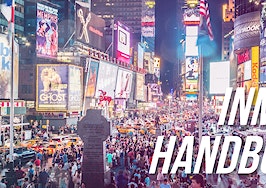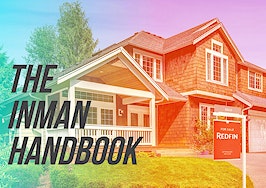 September is Marketing and Branding Month at Inman. That means we’re talking to the chief marketing officers at major brokerages about how the pandemic is changing their jobs and what it means for agents. We’re publishing a suite of tactical Inman Handbooks for marketing on digital portals. And we’re looking at what pages of the traditional marketing playbook still work. Join us all month long.
September is Marketing and Branding Month at Inman. That means we’re talking to the chief marketing officers at major brokerages about how the pandemic is changing their jobs and what it means for agents. We’re publishing a suite of tactical Inman Handbooks for marketing on digital portals. And we’re looking at what pages of the traditional marketing playbook still work. Join us all month long.
Jennifer Marchetti doesn’t have an easy job.
A year ago, the chief marketing officer at Realogy Expansion Brands was tasked with rebranding ERA — a venerable part of the Realogy family that has been around for decades. So Marchetti began doing research, surveying members of the ERA community and trying to figure out what they thought of the brand.

Jennifer Marchetti
“We found a couple of important things,” Marchetti recently told Inman. “The brand was viewed as experienced and full service. It was respected in the industry.”
But she also found that ERA appeared to have been “purposely informal” in its brand, and that while the company had a strong local culture it also seemed to need more structure for “agents and brokers to live the brand.”
“I wanted to codify it to give it almost like a visual identity and a tonal identity,” she explained. “To take what made it strong and codify it and then figure out where it can differentiate in places that can give it an edge.”

Credit: ERA
The results of this process were unveiled earlier this year and include new colors and a grid-like design that Marchetti described as a “tribute to a motherboard,” as well as to a local community map.
But the process also highlights the thought, effort and work that goes into real estate branding. That work looks different depending on who is doing it — an independent agent and Realogy are very different entities — but one thing is clear: Branding matters.
To understand how real estate professionals approach branding, and why it takes up so much of their time and effort, Inman reached out to a handful of experts. Here’s what they had to say:
Table of Contents
- Pinning down the definition of branding
- Why branding matters
- When to focus on branding
- How to figure out your brand
- Practical strategies to strengthen a brand
Pinning down the definition of branding
When most people think of branding, an image probably comes to mind. Maybe it’s McDonald’s golden arches. Or Target’s bullseye. Or the Starbucks mermaid.
Those are all iconic images that capture the essence of their respective brands. But the experts who spoke to Inman for this piece all argued that branding is not simply an image.

Rebecca Rose
“One of the biggest mistakes that people make is they think brand is their logo,” Rebecca Rose, co-founder and CEO of marketing firm Studeo, told Inman. “But brand is actually the story of who you are and what you stand for and what you believe.”
The idea, in other words, is that branding is a way to capture or express an identity with succinct images and visual signifiers. But the key part isn’t just the image, it’s the underlying idea.
Rose went on to say that branding, at its core, is about “asking yourself those fundamental questions” about values and identity. The visual language of the brand then becomes a manifestation of deeper ideas.

Nir Betan
“Logos should represent the answers,” she said, “not the other way around.”
Nir Betan, Studeo’s chief strategy officer, added that brand “really encapsulates a Realtors’ world view.”
“Every brand is really a story at the end of the day,” he added.
Others made similar points. Marchetti, for example, said that branding — as opposed to marketing more generally — is “why you get out of bed in the morning.”

Christy Murdock Edgar
“It’s what you stand for,” she continued. “What courses through your veins. It’s the generic code of what makes an entity come to life.”
And Christy Murdock Edgar, a coach and real estate writer, described a brand as an “identity” that begins with an idea that then grows to include an entire visual language.
“It can encompass everything from the name of your business to the head shot you use to your logo or the colors you use,” she explained. “Branding is the the thing you define yourself with and your marketing is the messaging you attach to that.”

Additional resources
- Inman Handbook: Effective marketing in changing times
- Your brand is you — have you answered these critical questions?
- 3 rules for keeping your brokerage’s branding in check
- Building a brand? Here are the top 5 do’s and don’ts
- Your branding is costing you money: Here’s how to fix it
Why branding matters
Betan said that, long ago, commercial relationships were based on personal interactions. Think of a small town shop where everyone knows, and trusts, the proprietor. In the modern world, however, most people don’t have personal relationships with the owner of, say, Walmart, and Betan explained that branding fills the resulting gap.
“That’s one thing a brand will do,” he noted, “it will actually stand in lieu of a human relationship.”
Obviously that’s true of any commercial experience, but Betan added that real estate is unique because transactions happen so infrequently. So whereas someone might build a relationship with the Starbucks brand each morning while buying coffee, that same person might only move once every few years or decades.
That means the real estate brand has to do some heavy lifting when it comes to building a relationship, and it’s all the more important to do branding effectively.
“It’s hard to build a relationship with someone over long stretches of time,” Betan explained. “Brand reenforces the story over and over and over again.”
Another, related, reason branding matters in real estate is because consumers rely heavily on the recommendations of their friends and family. Rose said recommendations hold so much sway because people need ways to find industry professionals they can trust.
That poses a challenge to real estate professionals who don’t naturally have a massive social network. But Rose said branding is the means for overcoming that issue and enticing clients who might not otherwise have an established relationship with an agent or broker.
“You can circumvent that and interrupt that with a good brand,” she said of consumers’ tendency to rely entirely on recommendations.
Marchetti also noted that effective branding at the brokerage and company level offers an array of other benefits as well.
“It helps with retention,” she said. “It helps consumers recognize local brokerages.”

Additional resources:
- 3 facets to consider when choosing your luxury brokerage
- Let tech lead! How to get more clients in 2021
- What’s in a name? Why naming and personal branding matter
- How to create customer personas — and why they’re important
When to focus on branding
Branding is an ongoing process that never really ends, but Rose suggested agents think about it very early on in their careers. That’s because a brand is about establishing a core identity and system of values, so figuring it out should actually precede more obvious steps like coming up with a logo.
“Brand comes way before that,” she added.
Rose also said that failing to get branding right can lead to difficult and costly work later on.
“It’s very hard to change it,” she said. “Companies will spend millions of dollars to change their brand. That’s much harder to do than to start out and create a brand from scratch.”
That said, companies do evolve their brands over time. So how does that work?
Probably the best current example of this is Coldwell Banker, which in early 2019 began a major rebranding effort. Much of the conversation about that rebranding has focused on the new visuals, but it’s significant that the core of the effort has revolved around the idea of the company as a “North Star” during consumers’ home search.
Which is to say, Coldwell Banker’s rebrand began with a focus on values and then translated that into various visual media.
Coldwell Bankers’ work offers a number of lessons regarding the evolution of a brand. In order to settle on the new branding, for example, the company embarked on a massive effort to gather input and feedback from its broker community. It field tested dozens of signs. And it ultimately compiled an entire standards guide with the results of the process.

Coldwell Banker’s new logo, left, beside the old logo. Credit: Coldwell Banker
All of which is to say that the project was detailed and painstaking. Smaller companies and independent agents might be less exhaustive, but the lesson here is that — much as Rose indicated — anyone considering a change to an existing brand should be prepared to › a considerable amount of effort to get it right.
The Coldwell Banker case also hints at when a refresh might be in order. When the company announced its rebranding, leaders such as Chief Marketing Officer David Marine explained that there seemed to be a gulf between the company’s many strengths and the perception of the brand. For example, some thought the existing logo, which had existed for 40 years, was old and outdated. Others had noted that it worked poorly on phones and digital devices — all of which were invented long after the company adopted the logo.
Those factors led the company to start rebranding in 2019, and just days ago multiple Coldwell Banker executives noted that this particular moment was the right time for them to undertake the effort.
The takeaway is that the cost of rebranding eventually becomes worth it as a brand’s signifiers wan in effectiveness.
And while this may be a fairly labor intensive process, it can be worth it.
“Not only is it never too late to make sure that a brand is as strong and clarified as it can be, but it’s a necessary and important thing for a brand to go through in its life,” Marchetti explained.
But whether it’s at the beginning of a company or midway through it’s lifespan, getting a brand right is something that takes time.
“Don’t rush,” Nikki McCarthy, marketing director for a Better Homes and Gardens franchise in Florida, told Inman. “I’ve seen people rush to do branding that might not necessarily be them.”

Additional resources:
- After 40 years, Coldwell Banker begins rolling out a new logo and branding
- The 3 W’s of personal branding in real estate
- Century 21’s CMO shares the secret to a successful rebrand
- Coldwell Banker’s CMO on building a marketing play amid uncertainty
- Century 21 unveils ‘big, bold, ambitious’ rebrand
How to figure out your brand
Nikki Beauchamp had a breakthrough with her branding when, a decade ago, she set out to work on her website.

Nikki Beauchamp
“I thought, ‘doesn’t it make sense to ask the people who have worked with me what their perception is of my brand?'” she recalled. “What things did they find most important and what things did they find less important.”
That exercise eventually led Beauchamp, who is with Engel & Völkers, to hit on a brand of “kind of being no BS.”
“That feels, to a lot of people, very different from what they perceive the role of an agent — or from agents they’ve had in the past,” she explained.
Each agent’s branding will ultimately vary, but the point is that what began as a simple website design process for Beauchamp grew into a kind of on-the-ground market research project where the point was to identify core values. It’s a process that forges a stronger connection with clients — “it shows them I valuable their opinion,” she said — and which she also suggested other agents try.
“I think we all generally have people that we know,” she said. “People that we trust. And who better to go to than those people to sort of get a sense of the qualities that other people believe you to have.”
This process can be tough, but if agents are open minded and willing to accept feedback “it can be a really, really eye opening experience,” Beauchamp added.
Beauchamp’s experience offers insights into one potential way to identify what a brand ought to be, but there are plenty of others. Betan, for instance, suggested agents figure out a niche and then zero in on it.
“The ones who crack it are the ones who figure out some kind of geographical farming strategy,” he said.

Nikki McCarthy
McCarthy also suggested agents looking to pin down their brand can lean into the things that make them unique.
For example, she knows one agent who loves the beach, so his branding revolves around that. His headshot was taken at the beach, he uses color schemes are dominated by blue and green and even the domain name for his website mentions the beach.
The result is that everything reflects his interests and offers a way for potential clients to understand who he is and why they might enjoy working with him.

Additional resources:
- This is the least memorable way to brand your business — don’t do it
- Branding with your name in real estate? Come on, you can do better than that
- Who’s your target audience? 5 key groups to focus on
- The secret to finding your perfect brand and marketing plan
Practical approaches to strengthen a brand
When new agents come to McCarthy’s brokerage, one of the first things they do is sit down with the marketing department.
“If they had a brand beforehand, if they like it, we’ll keep it,” she said. “But we’ll create a whole new logo for them. We like to get updated headshots. We want everything to look clean, cohesive, trendy. We’ll do a social media revamp to make sure all the links are working.”
This process revolves around the core values and identity the agent wants to convey, but the experience also highlights some of the very practical considerations real estate professionals have to consider when building a brand. In other words, at some point things like logos and photos do actually matter.
The experts who spoke to Inman stressed that agents need to get these things right, though there are many ways to do that. Some professionals at larger companies will have whole teams to help them. For others, there are third party vendors, such as Rose’s and Betan’s company, which helps agents create a magazine-like document that’s meant to convey brand identity.
But agents also don’t have to spend a lot of money.

Edward Barrios
Edward Barrios, a Sotheby’s International Realty agent in the Los Angeles region, told Inman that ongoing “lifestyle” branding can be expensive and time consuming. So instead he has chosen to focus his brand on being knowledgeable, and on “the product, because that’s the one thing I could be cost effective with.”
Practically speaking, that means Barrios — who went into real estate after years in marketing — spends his resources highlighting the homes he’s working with, rather than his personality. He makes sure to have high quality photos and clean copy. And he promotes his knowledge of the housing market, including various social and political issues that may be relevant. He also works with a local charity, and together the idea is that all of these things create an identity that clients can understand.
Practically speaking, most agents will also eventually end up doing some branding work on social media, and Katie Lance, a real estate consultant, told Inman there are a number of best practices for doing that.
“I think the mistake a lot of agents make is they try to be all things to all people,” she said. “When you try to be all things to all people I think that what happens is you become a generalist. But typically speaking, people want to work with a specialist.”
Lance urged agents to think of ways to translate their brands into useful content. For example, if an agent’s identity revolves around luxury, they might want to post useful information online about buying second homes or investment properties. On the other hand, if the agent is trying to cater to first-time homebuyers, they’ll want to take a different approach.
“You can start to think if there is some content you can create that speaks to that kind of person,” she added. “Then you become really relevant to that specific audience. If you can, think about how you can be of service to someone else.”
Lance additionally suggested one way agents can help build their brands online is by producing original content such as blogs or videos.
“That goes with you where ever you go,” she said.
This process isn’t easy or fast, but Lance said that it captures the idea that it’s better to attract business than to chase leads. And in the end, there isn’t really a shortcut for building an effective brand.
“You have to just put in the work,” she said. “Putting together a plan, putting together a strategy, is just critical to success.”

Additional resources:
- Growing your brand through YouTube? 3 tips to start off strong
- 5 tips for consistent branding
- TikTok for real estate: How to harness this next-gen social media app
- Inman Handbook: Optimizing your Zillow profile for maximum impact
- As ban looms, here are some of the best real estate TikToks we’ve seen
- Almost 5 years later, Studeo still tells great listing stories
- How to build an irresistible personal brand in real estate
Update: This post was updated after publication with additional comment from Marchetti.













